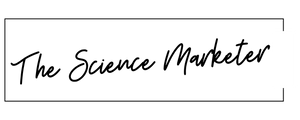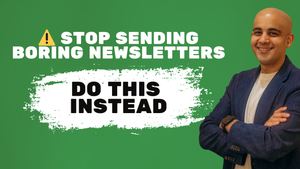The "build-in-public" movement is a concept that encourages startup founders to share their journey and lessons learned as they build their companies. It's been around since the beginning of the tech industry, with SaaS and software companies being the most common examples.
The spread of social media and blogging platforms into our daily lives has further fueled the growth of the built-in-public community and extended its reach to other founders.
At its core, building a business in public means being transparent about both the successes and failures an entrepreneur will encounter along the way, in order to create a brand that people can relate to, or learn from.
What's always surprised me is the lack of examples in the biotech industry. Yes, this industry has to be more opaque than others because of its highly regulated nature, but founders always confuse intellectual property (which you have to protect by any means) with the value of sharing your company's story.
So, when I stumbled upon Steve Harvey's profile on LinkedIn, I was immediately intrigued. It was one of the first times I had seen an entrepreneur openly share the behind-the-scenes story of a biotech company, and it was incredibly refreshing.
Steve is the co-founder and CEO of Camena Biosciences, a company specializing in DNA synthesis. During our recent community call (an exclusive perk for subscribers to my newsletter, so be sure to subscribe), I had the opportunity to interview Steve to delve deeper into what led him to embrace the practice of building his biotech in public.
Here's what I gleaned from our conversation.
How it all started
Steve didn’t wake up one day with the sudden ambition to become a LinkedIn influencer. About two years ago, he realized that LinkedIn could be a valuable asset for his company after facing a harsh reality:
"In the early phase of the company, a few people came to me and said, 'I've been to your website and I don't understand what you do.'"
His first reaction was to pull the team together to come up with a solution. The idea was simple: if he could create a survey that collected what people thought about his company and brand, he could use it as a blueprint to improve the message.
”We put the survey out and after about two weeks we had below 10 responses. And one was the mum of an employee.”
Unsurprisingly, the responses went nowhere, so Steve tried again, this time offering a £25 Amazon gift card to one lucky winner.
The result: an astonishing 2,000 responses in two weeks. But with that came the fact that around 70% of respondents had only heard of Camena in the last three months, a result the team had not expected at all.
“We went from joking to panic mode. At the time we were coming to the point of commercialization. So we were moving to a point where we needed people to know what we do. And here we are, thousands of people have responded and hardly anyone knows what we do.”
And that is how it all started. Shortly after the survey, Steve made a public declaration that he would use LinkedIn to tell Camena's story. Since then, he's been posting several times a week and recently surpassed 10,000 LinkedIn followers.
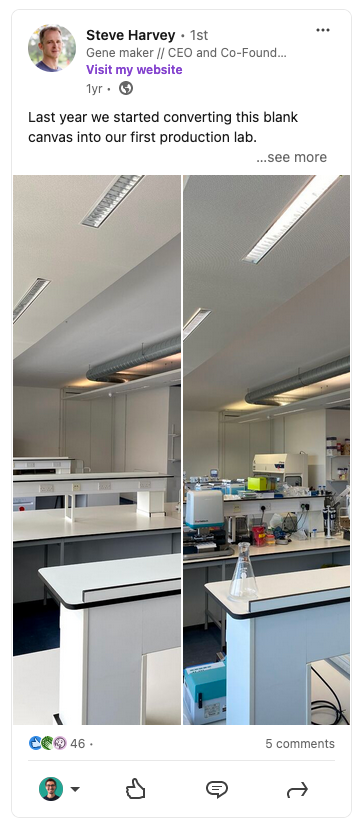
How did Steve learn the LinkedIn language? By experimenting and learning from others.
From scientist to writer
Steve is a scientist by training, and it's clear from our conversation that he's still a DNA geek at heart (he told us a fascinating story about the early days of DNA synthesis, but I had to cut it from this article to keep it short).
So when he stumbled upon LinkedIn, he had to learn as fast as he could to make sense of the platform.
”I decided that I would teach myself how to use social media channels to tell our story. I took a few courses on using LinkedIn and creating content and that was the beginning of us starting on LinkedIn.”
The initial goal was simply to tell the company's story to as many people as possible. Steve knew this would work after stumbling upon some inspiring examples:
”In the UK, there's a sportswear company called Gymshark, and the CEO of the company, Ben Francis, is very open about the story of how he started. He was delivering pizzas from Pizza Hut and then using that money to support the early phase of making clothes. He started to vlog about the whole thing, the whole story. It really pulls you in, and you become connected to the brand in a way that I thought was really compelling. I thought if we could do an equivalent thing, that would be a very good way to organically build our audience without really spending any money.”
In essence, what Steve discovered was what many public builders had realized before: through transparency and storytelling, you can build a strong relationship with your audience and increase their attachment to your brand.

Gymshark is now worth over a billion dollars, and for many, that success has a lot to do with Ben Francis' openness about his company (the clothes are apparently pretty good, too).
But being the storyteller behind a brand doesn't come without structure, so I asked Steve how he manages his LinkedIn content.
Steve Harvey’s LinkedIn workflow
As you scroll through Steve's LinkedIn feed, you can see that his posts have changed a lot over the past two years.
”The company has gone through three different phases over the last two years and the way that the content is generated is probably a similar type of cycle. When we started, the goal was just to tell the story. Good and bad. But then, we had to evolve to a relatively aggressive recruitment phase. To prepare us for that recruitment phase, I then started to talk more about what it’s like to work at the company. Now we're in a scaling phase for the company, we're generating millions in revenue, and we've raised a lot of capital. So now the messaging has changed away from what was the story of an individual to the story of the organization and how we're building the organization.”
When it comes to content style, Steve recommends two things: mix up your post formats (text, images, video, etc.) and look at the latest trends.
“What's really interesting to do is to study high-growth accounts and notice the trends, which kind of come and go. There was a period when carousels were very popular. Someone had set a trend for carousels and then people started to copy that. And then either people get bored of that type of format or the algorithm penalizes those types of things. For example, those days there's a trend that you'll see with a lot of people taking photos of handwritten notes. Or they're holding whiteboards with text on it. And it looks like they just put more effort into providing content for someone to engage with. I think it's important just to keep it fresh in how you present your story.”
One question I like to ask people who post on LinkedIn is how they structure their content throughout the week (I also asked Amber Penrose here). Here's how Steve does it:
”It's not completely structured. I probably post something specific about our products every 20 posts. So it’s only a very small amount. The other content is sliced into different areas. Some of the content that creates the most reach will be related to an industry trend, so it's nothing to nothing to do with us. If you do it early on when that news comes out, you'll get a huge number of impressions. But your conversion to meaningful connections is not necessarily equal to that. Then we would talk about something broad in a company-building sense or in applications of DNA and then we become more and more niche by going down and down. So we may get to a point where we talk very specifically about a key element of what it’s like to work at the company, or a very specific kind of application of our technology.”
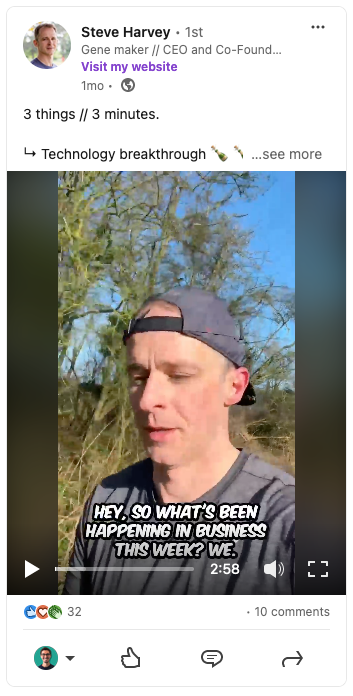
Steve is actively posting on LinkedIn, and as you can imagine, this takes time away from the day-to-day responsibilities of running a business.
So how does he recoup his time investment?
Building an authentic brand on LinkedIn
Accurately measuring the impact of your brand on LinkedIn is a difficult task. Sure, you can measure inbound leads and the revenue they generate, but that direct result is often only part of the indirect benefit.
“We have customers who contact us through LinkedIn and we generate revenue from that contact. So there is an effect of getting the message out there. That's one thing. But then I find myself being invited to things that I have never been invited to before. On Thursday, I'm going to 10 Downing Street [the residence and office of the British Prime Minister]. It's an anecdotal story, but I think it's an example of how the voice we've created has generated a lot of interest."
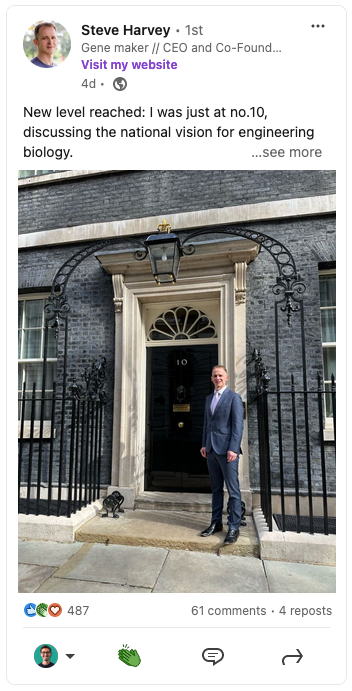
Another area where LinkedIn has produced incredible results is in recruitment marketing:
”We've interviewed people and we've asked, ‘Are you applying to work anywhere else’? And they said no, I'm only applying to work with you because I've read your content on LinkedIn. It's very rare that we struggle to recruit people and I think that is a direct consequence of content.”
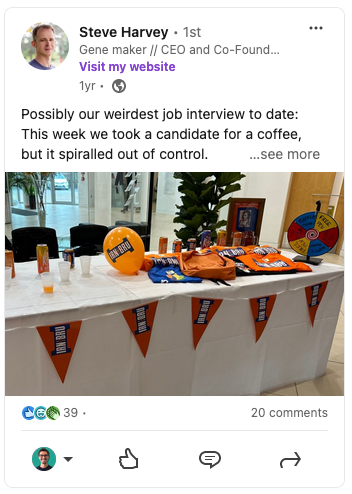
The secret to this appeal is the authenticity of Steve's posts and the fact that he puts his own time and thoughts into LinkedIn:
“I just came to the conclusion really early on that there's no way for it to be successful as a form of messaging if it comes from a Ghostwriter.”
Brand awareness is notoriously difficult to measure, and building a company in public is undoubtedly a part of that challenge. As I explained in my article on content marketing, the benefits of creating content may not show up for several years, and the fact that they can't be rigorously tracked makes it even harder for companies to commit to these strategies.
That's why you often see companies post on LinkedIn for a few weeks or write two or three articles on their website and then abandon the initiative altogether. They don't make the commitment that Steve made early on.
A person might read a post by Steve today and start following him without taking any further action. Ten years from now, that person's situation might change and they might be interested in a DNA synthesis service. What will immediately come to mind? Chances are it will be Steve and Camena.
Building in public is a challenge for this reason, but it's not the only one.
Challenges of building in public
As an entrepreneur myself, I’ve often faced the dilemma of being transparent about my business without sacrificing my time or getting completely sucked into the “transparency game”.
I have a lot of respect for companies like Buffer, which decided early on to make pretty much everything public, to the point where every employee’s salary can be accessed online (even the CEO). But that kind of decision has a lot of implications for the company and the culture you're building, so without questioning the benefits of building in public (because I still think some transparency helps in the grand scheme of things), I asked Steve to talk about the challenges entrepreneurs might face:
”I think some people can get it wrong. I saw a CEO criticizing their Glassdoor reviews in a video and it came across as very arrogant. The comments were not great. But even in that case, I think it's forgotten quickly. A lot of people have a barrier to writing content where they feel that everything has to be perfect for one post and they put so much effort into writing one post. And actually, it's forgotten the next day.”
Sharing ill-advised or polarizing content may not be the best idea, especially on LinkedIn, because every piece of content you create also reflects the company's brand in some way.
Another common objection from busy entrepreneurs is the time it takes to maintain this kind of personal branding, and again, Steve has a positive take on the topic:
”When I started doing this, I found it to be a huge time burden and I think over time you develop kind of rapid mechanisms for creating content. We do things now that create content in a sliced and diced method that reduces the burden a little bit more. As the company has grown, I've always kept the element of being the main spokesperson for the company and trying to be the storyteller of what we're doing. I'll probably keep that for quite a long time.”
Becoming a public figure also comes with its own challenges. Sometimes, being in this industry makes you forget that scientific facts can be perceived in different ways by non-experts, and Steve was recently reminded of this:
“There was an interesting story about the mRNA vaccines and the discovery of pseudouridine. It was an important part of how mRNA vaccines became so effective and there was a story about how pseudouridine leads to slippage as the enzymes move along. Okay, so the vaccines work. That's clear. But its slippage ends up creating different types of antibodies, and probably lots of them are junk. I put that out and just kind of reported what was being said. A few people commented to say, ‘You have to be really careful of this type of content.’ In the public, some people were worried about the vaccine, so it may drive fear. It was the first time I thought, actually, I'm gonna have to be a little bit careful about how I describe some of these things.”
However, because of its professional nature, LinkedIn remains a microcosm where criticism is not as harsh as on other platforms.
“If I write a post, it’s almost guaranteed that someone will not like it, right? And if someone posts a relatively negative comment, I think that's a sign it's about to go crazy. I had a post earlier this year, the first comment was pretty negative. And then it had 200,000 impressions, for just one post… which just is insane. But I've generally found people are pretty positive on LinkedIn. If you go to Twitter, it’s savage.”
Criticism and time commitment are among the most common challenges you'll face as you build your business in public.
What Steve never mentioned, however, is trade secrets, and it's obvious to me that this argument is not relevant. Even if building in public means sharing some internal information, you still control the story you tell.
Having a dedicated spokesperson in your company, as Steve does for Camena, is also a great way to ensure that information goes through one channel and is therefore easier to control.
With that in mind, Steve shared a few other tips with me.
One last advice to founders
To wrap up our discussion, I asked Steve what advice he would give to other founders just starting out:
”I’ll probably get them signed up for a copyrighting course. The benefits of that are way beyond just producing content. It’s helping them to articulate what they are doing. How are they interacting with investors? How are they going to hire people? All those types of things. I would encourage people to just start to tell their story and to begin to use it as a channel for them and the business as well. We've seen great benefits from taking that strategy.”
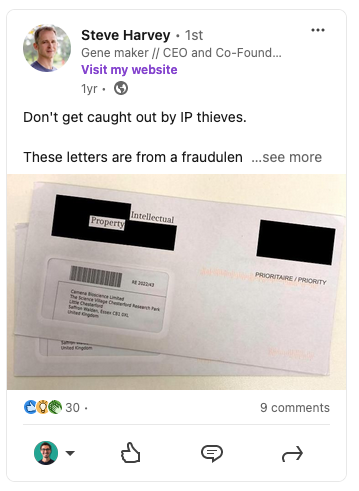
As social media platforms are rapidly evolving, I also wanted to know what Steve thought about the future of LinkedIn for the biotech industry:
“I think LinkedIn is gonna remain the main platform for biotech. There's a lot of growth still to be had on LinkedIn. I've seen some people move into other platforms, which I think remains a little bit experimental.”
His view resonated with my own thoughts on which platforms are most useful right now. Twitter is slowly dying because of its magalomaniac owner, while TikTok and Instagram are mostly entertainment.
Still, if a company has a broader application to a general audience, a platform like TikTok could have some value, and Steve had a good example to share:
”The Francis Crick Institute did a really cool thing on TikTok where they just walked around and asked people what they do. And they got all these people across the institute talking about their research. So they drove a lot of organic engagement that way. I thought that was pretty cool.”
The most important lesson I take away from this interview with Steve Harvey is that building a business in public is a great way to tell your business story in an authentic manner. The benefits are many, from finding your first customers to hiring the dream team. A great lesson for any marketer or entrepreneur.
